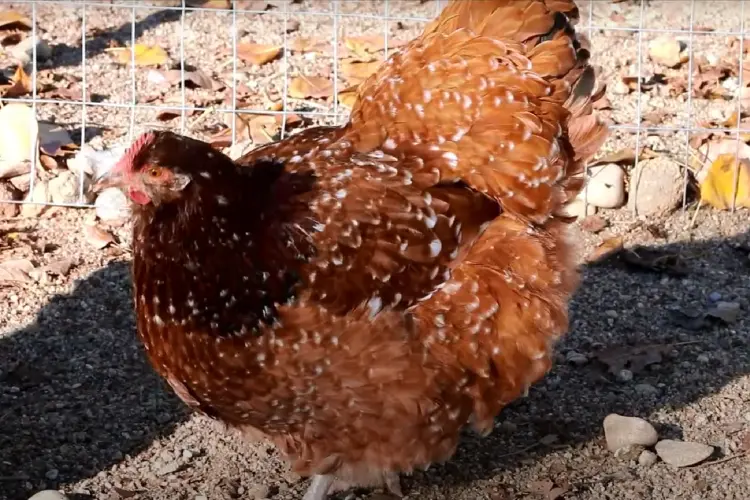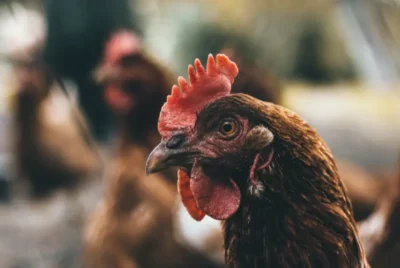Jubilee Orpington Breed Information and Characteristics
Choosing a chicken breed can be confusing. With so many options out there, how do you find one that’s friendly, good for eggs, and easy to care for? If you’re feeling lost, let’s talk about the Jubilee Orpington. This chicken might just be the perfect match for your backyard needs. Let’s find out why.
Quick Facts About Jubilee Orpington
- Type: Suitable for both meat and egg production
- Size: Large breed
- Heritage: Not a traditional heritage breed
- Average Mature Weight: 7 to 8 pounds
- Weeks To Maturity: Approximately 24 weeks
- Average Life Span: 5 to 10 years
- Color Variations: Speckled appearance
- Egg Size: Large
- Egg Color: Cream brown colored eggs
- Egg Production: More than 250 eggs annually
- Temperament: Gentle and sociable
- Beginner Friendly: Yes
- Kid Friendly: Absolutely
- Heat Tolerance: Prefers cooler climates
- Cold Tolerance: Excellent
- Comb Type: Single comb
- Broodiness: Often sits on and hatches eggs
- Flightiness: Low, due to large size
- Noise Level: Generally quiet
History of the Jubilee Orpington Chickens
The history of Jubilee Orpington chickens is a tale dating back to the 19th century. These chickens were originally part of the Orpington breed, which was introduced by William Cook in England over a hundred years ago.
Cook named the breed after the town of Orpington in Kent, where he lived. Over time, as the Orpington breed gained popularity, William Cook’s family created new color varieties.
In 1897, this breed was born. It was originally called “Diamond Jubilee Orpingtons” to honor Queen Victoria’s Diamond Jubilee, which celebrated her long reign as the Queen of England. As a special tribute, the Diamond Jubilee of Queen Victoria received a flock of these regal-looking chickens.

The Jubilee Orpingtons were developed through careful breeding, likely involving other chicken breeds like Spangled Old English Game, Dorkings, Buff Orpingtons, and possibly Speckled Sussex. This breeding process resulted in a distinctive brown-speckled appearance, but they are still rare in the United States.
These chickens have a storied history and have become beloved for their historical significance, striking appearance, and friendly nature. They remain a favorite among poultry enthusiasts and remind them of their royal origins.
Physical Appearance of Jubilee Orpington Chicken
Jubilee Orpingtons are large, fluffy chickens known for their eye-catching rare color pattern. They have a robust and full body shape.
Their feathers are the highlight, featuring a mahogany background color adorned with black and white speckles, along with a bright crimson and emerald sheen. These intricate feather patterns take about 18 months to fully mature, becoming even more beautiful as the Jubilee Orpington chicks age.
These chickens are covered in dense, fluffy feathering, especially on their thighs and buttocks, which display a mix of brown, white, and black. Their faces, earlobes, combs, wattles, and eyes are red, contrasting with their white beaks, legs, and feet.

Behavior and Temperament of Jubilee Orpington
The behavior and temperament of Jubilee Orpington chickens are characterized by their calm and friendly disposition. These birds are known for being exceptionally friendly, not only with their fellow Orpingtons but also with other types of chickens.
They are big but don’t use their size to intimidate smaller birds, making them easygoing in mixed flocks. Jubilee chickens are also great with humans, including children, and are considered a good choice for families. They are so gentle that they don’t mind being picked up and can even be lap chickens if you like.
However, it’s essential to be aware that they may need protection from more dominant or aggressive chickens in a mixed flock, as their friendly nature can sometimes make them targets.
Additionally, although it’s rare, they may become noisy or agitated when stressed, so it’s important to provide a stress-free environment for their well-being.
Egg Laying Production of Jubilee Orpington Hens
The average egg production of a Jubilee Orpington hen is about 200 eggs per year. However, some can lay up to 280 eggs annually, but this might depend on factors like the hen’s health, diet, environment, and overall care.
The eggs they lay are of a good size and have a lovely light brown tint. These eggs are not only nutritious but also aesthetically pleasing, making them a favorite for many homesteaders and backyard chicken enthusiasts.
Additionally, they are good for both meat and egg production. Their plump bodies offer a decent amount of meat, making them an excellent choice for those who might want to raise chickens for both purposes.
If you’re interested in hatching your eggs, Jubilee Orpingtons are known for their broodiness. They often have strong mothering instincts, which makes them excellent for hatching and raising chicks. This trait also ensures that you can naturally expand your flock.
Read also: 20 Best Giant Chicken Breeds ( For Meat + Egg Production)

How to Take Care of the Jubilee Orpington
Free-Range
Jubilee Orpingtons thrive when given the chance to free-range. This allows them to roam outside, peck at the ground, and explore their surroundings. Free-ranging allows them to exercise, find insects and worms to eat, and enjoy the natural environment. It’s a great way to keep them healthy and happy.
If you’re concerned about predators, consider supervised free-ranging sessions or provide a secure outdoor area for them to enjoy.
Chicken Coop
This breed needs a spacious and comfortable coop. Given their size, each bird requires a minimum of 4 square feet of space, but more is always better. The coop should be well-ventilated, protected from drafts, and safe from predators. I recommend ensuring the coop is cleaned regularly to maintain a hygienic living environment for the chickens.
Nesting Boxes
Jubilee Orpingtons, being enthusiastic layers, appreciate a cozy nesting box for laying eggs. A standard 12×12-inch box is usually adequate, even though they’re a large breed.
I suggest placing these boxes in quiet, dimly lit areas of the coop to give the hens some privacy. It encourages them to lay their eggs consistently in the boxes rather than random spots in the coop or yard.
Diet
Feeding your Jubilee Orpington a balanced diet is crucial for their health and productivity. Start chicks on a high-quality feed with at least 20% protein. As they mature, transitioning them to a standard layer feed will suffice.
Given that they’re not always the best foragers, complement their diet with leafy greens, fruits, and occasional treats like mealworms. I advise avoiding overfeeding, as this breed can easily become overweight, leading to health issues.

Common Health Problems
- External Parasites – Lice and mites, are especially problematic due to their thick plumage.
- Obesity – Lack of exercise and overfeeding can lead to excessive weight gain, making them more susceptible to various health issues.
- Heat Stress – This breed struggles with extreme heat. Signs include panting, lethargy, and holding wings away from the body.
- Egg Binding – This condition occurs when a hen cannot lay an egg. It’s more common in larger breeds and can be exacerbated by obesity.
- Worms and Internal Parasites – Regular deworming is essential to keep them free from internal parasites.
Remember, while these are potential health problems, with proper care and management, many can be prevented or effectively treated. Regular health checks and observation will help in early detection and intervention.
Read also: All About the Lavender Orpington: Care and Breeding Tips
So, Are Jubilee Orpingtons Good for You?
Deciding if Jubilee Orpingtons are the right fit for you depends on what you’re seeking in a chicken breed. If you’re considering venturing into poultry, whether for a cozy backyard setup or a more extensive egg-producing endeavor, this decent brown egg layer breed might be the bird you’re looking for.
These birds offer not just a visual treat with their unique speckled plumage but also practical benefits in terms of egg production and meat yield.
Moreover, their gentle demeanor makes them an excellent choice for families with kids, and beginners will appreciate their forgiving nature.
However, if you’re still on the fence and exploring other breeds, you can check out our “Beginner’s Complete Guide to Selecting the Best Chickens“. It’s packed with comprehensive insights on various breeds, helping you make the most informed decision for your poultry journey.




